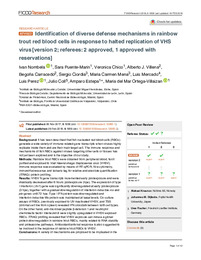Title:
Identification of diverse defense mechanisms in rainbow
trout red blood cells in response to halted replication of VHS
virus [version 2; referees: 2 approved, 1 approved with
reservations] |
Authors:
Nombela Díaz, Iván
Puente Marín, Sara
CHICO GRAS, VERONICA 
Villena, Alberto
Carracedo, Begoña 
Ciordia, Sergio 
Mena, María Carmen
Mercado, Luis 
Pérez, Luis
Coll Morales, Julio
Estepa Pérez, Amparo
Ortega-Villaizan Romo, María del Mar |
Issue Date:
2018-02-09 |
URI:
http://hdl.handle.net/11000/6990 |
Abstract:
Background: It has been described that fish nucleated red blood cells (RBCs) generate a wide variety of immune-related gene transcripts when viruses highly replicate inside them and are their main target cell. The immune response and mechanisms of fish RBCs against viruses targeting other cells or tissues has not yet been explored and is the objective of our study.
Methods: Rainbow trout RBCs were obtained from peripheral blood, ficoll purified and exposed to Viral Haemorrhagic Septicaemia virus (VHSV). Immune response was evaluated by means of RT-qPCR, flow cytometry, immunofluorescence and isobaric tag for relative and absolute quantification (iTRAQ) protein profiling.
Results: VHSV N gene transcripts incremented early postexposure and were drastically decreased after 6 hours postexposure (hpe). The expression of type I interferon ( ifn1) gene was significantly downregulated at early postexposure (3 hpe), together with a gradual downregulation of interferon-inducible mx and pkr genes until 72 hpe. Type I IFN protein was downregulated and interferon-inducible Mx protein was maintained at basal levels. Co-culture assays of RBCs, previously exposed to UV-inactivated VHSV, and TSS (stromal cell line from spleen) revealed IFN crosstalk between both cell types. On the other hand, anti-microbial peptide β-defensin 1 and neutrophil chemotactic factor interleukin 8 were slightly upregulated in VHSV-exposed RBCs. iTRAQ profiling revealed that VHSV exposure can induce a global protein downregulation in rainbow trout RBCs, mainly related to RNA stability and proteasome pathways. Antioxidant/antiviral response is also suggested to be involved in the response of rainbow trout RBCs to VHSV.
Conclusions: A variety of mechanisms are proposed to be implicated in the antiviral response of rainbow trout RBCs against VHSV halted infection. Ongoing research is focused on understanding the mechanisms in detail.
|
Keywords/Subjects:
nucleated red blood cells
rainbow trout
VHSV
rhabdovirus
immune response
antiviral |
Knowledge area:
Bioquímica. Biología molecular. Biofísica |
Type of document:
info:eu-repo/semantics/article |
Access rights:
info:eu-repo/semantics/openAccess |
DOI:
https://doi.org/ 10.12688/f1000research.12985.2 |
Appears in Collections:
Instituto de Biología Molecular y Celular
|

.png)
